
* Nikolai Nikolaevich Polikarpov was a pioneer of Soviet aviation, having gone to work for the great Igor Sikorsky in 1916 and working on the ILYA MUROMETS heavy bomber. During the Russian Revolution that followed the Great War, Sikorsky went to America while Polikarpov became a loyal citizen of the Soviet state, developing a series of aircraft. The fighter designs of his design bureau (an OKB in its Russian acronym) were particularly noteworthy, giving him the nickname of the "King of Fighters" -- the most prominent among them being the "I-15" biplane, along with its "I-153" refinement, and the "I-16" monoplane. This document provides a history and description of Polikarpov fighters.

* Nikolai Polikarpov first established his reputation as an aircraft designer by developing the "R-1" light bomber for the VVS (Voyenno Vozdushniye Sily / Red Air Force) -- or rather adapting it, the R-1 being an unlicensed copy of the British Airco DH.9. Polikarpov modified it to use different engines as available, and designed a number of variations, such as a floatplane version. Thousands of R-1s were built, the aircraft leading to the follow-on Polikarpov "R-4" and notably the Polikarpov "R-5", which was built in very large numbers. Polikarpov also worked on trainers, culminating in the Polikarpov "Po-2", his most famous aircraft and one of the most heavily produced aircraft in history.
Polikarpov's work on fighters began with the "I-1" of 1923 -- the "I" standing for "istrebitel (fighter)" -- a low-wing monoplane, made of wood and fabric, with fixed landing gear and a copy of an American Liberty vee-12 water-cooled engine. The I-1 was built in small quantities and never entered service, having nasty handling characteristics. A prototype of a two-seat biplane fighter, the "DI-1", followed in 1926, but crashed after a handful of flights; no others were built.
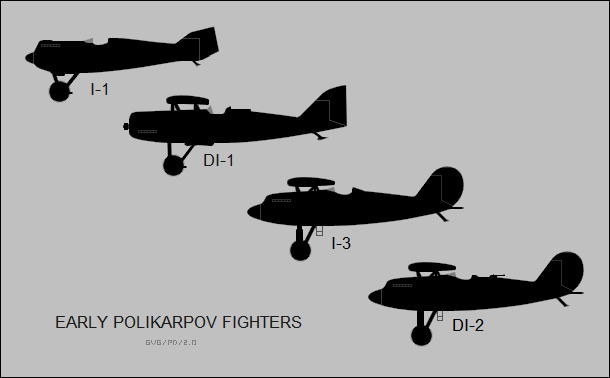
Despite the setbacks, Polikarpov continued to develop fighters, rethinking the DI-1 considerably to come up with the "I-3" single-seat fighter, which performed its first flight in 1928. It was a biplane, with the lower wing being of shorter span than the top wing, as would be true of all Polikarpov's biplane fighters; fixed landing gear; wood / plywood / fabric construction; a Mikulin M-17 liquid-cooled vee-12 M-17 engine; and armament of twin 7.62-millimeter (0.30-caliber) machine guns. It went into production, with almost 400 built, the type serving into the mid-1930s and then retired to secondary roles. A prototype of a two-seat derivative, the "DI-2", was built, but it crashed and nothing more was done with that idea.
* Following the I-3, Polikarpov moved on to two comparable designs, the "I-5" and "I-6", the initial prototypes of both being flown in 1930. They were both biplanes, with fixed landing gear and tailskid, twin 7.62-millimeter PV-1 machine guns synchronized to fire through the prop arc, and radial engines. The I-5 was powered by a Shvetsov M-22 nine-cylinder air-cooled radial engine with 360 kW (480 HP), the M-22 being a copy of the British Bristol Jupiter radial, with imported engines used in prototype development. The aircraft was of highly mixed construction -- steel tube framing, wood framing, with metal / fabric / plywood skinning -- and the engine was enclosed in a Townend-type ring cowling. The I-6 featured the same powerplant, but was of mostly wood and fabric construction, with no cowling over the engine cylinders.
Polikarpov inherited the two projects from Andrei Tupolev's OKB, Tupolev being overburdened working on bombers. Prototypes of the two aircraft were supposed to fly in 1929, but they didn't make the deadline -- a term that had only too literal a meaning in the USSR. Failures to perform as desired were regarded as sabotage, treason, and so Polikarpov was arrested by the OGPU -- the security service, the ancestor of the KGB -- and sentenced to be shot. The sentence was quickly amended to ten years in a prison camp, Polikarpov ending up in a peculiar Soviet institution known as a "technical prison", an engineering facility with the brains provided by prisoners. It seems death sentences for personnel who were seen as valuable to the Soviet state were often, though not always, commuted.
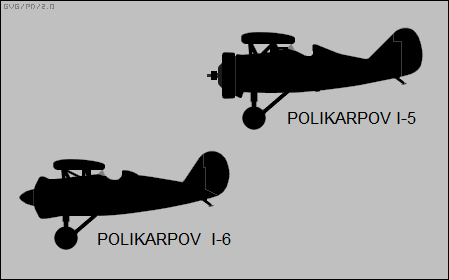
This malevolent rigamarole of course further delayed the program, with the first of two prototypes of the I-6 flying on 30 March 1930, the first of three prototypes of the I-5 following on 30 April 1930. The two machines were very similar in performance, but the I-5 was perceived as having a slight edge, so it was chosen for production over the I-6; the crash of one of the I-6 prototypes may have influenced that decision. First deliveries of the I-5 to the VVS were in 1931. Polikarpov, it appears partly because of the perceived utility of the I-5, was released from imprisonment and rehabilitated in 1933, to continue aircraft development.
___________________________________________________________________
POLIKARPOV I-5:
___________________________________________________________________
wingspan:
10.24 meters (33 feet 7 inches)
wing area:
21.3 sq_meters (229 sq_feet)
length:
6.78 meters (22 feet 3 inches)
height:
3 meters (9 feet 10 inches)
empty weight:
935 kilograms (2,060 pounds)
loaded weight:
1,355 kilograms (2,987 pounds)
max speed at sea level:
280 KPH (175 MPH / 150 KT)
service ceiling:
7,500 meters (24,600 feet)
range:
660 kilometers (410 MI / 355 NMI)
___________________________________________________________________
The VVS found the I-5 satisfactory, performance being equal or superior to contemporary foreign fighters, though it was not seen as a pilot-friendly aircraft. Along with the two machine guns, it could also carry light bombs. Although production quantities of Polikarpov's aircraft tend toward the uncertain, the number of I-5 fighters built is given as over 800. A few two-cockpit trainers, designated "I-5UTI" -- where "UTI stood for "Uchebno-Trenirovochniy Istrebitel / Fighter Trainer" -- were also built. Most I-5s flew with the VVS, but a minority flew with the Red Navy's aviation arm. That would be the case for all mass-production Polikarpov fighters from then on, though their service with Naval Aviation remains obscure.
The last I-5s were rolled out in the mid-1930s. Aircraft design was moving rapidly at the time, and just as the last I-5s were being built, the type was being phased out of service in favor of improved fighter aircraft designs. The I-5 was mostly relegated to advanced flight training after being withdrawn from first-line service. After the German invasion of the USSR on 22 June 1941, I-5s were pressed into combat as light attack aircraft and night bombers, operating in that role into early 1942.
BACK_TO_TOP* Following his release from imprisonment in 1933, Polikarpov conducted development of a refined derivative of the I-5. Initial flight of the result, the "I-15", was in the fall of 1933, with Valery P. Chkalov at the controls. Trials proving the aircraft highly satisfactory, it was put into production in 1934.
The I-15 was clearly a refined I-5. It was a biplane of mixed construction, with an M-22 engine in a Townend ring cowl, fixed landing gear, and twin 7.62 millimeter PV-1 machine guns. Changes included I-style wing struts, single-strut main landing gear, and notably the top wing "gulled" inboard into the top of the fuselage. 404 M-22-powered I-15s were built. Because of the top gulled wing, VVS pilots called it the "Chaika (Gull)". The I-15 was unsurprisingly similar in performance to the I-5; pilots reported it suffered from longitudinal instability, and some did not like the gull upper wing, since it resulted in "tunnel vision" on the ground.
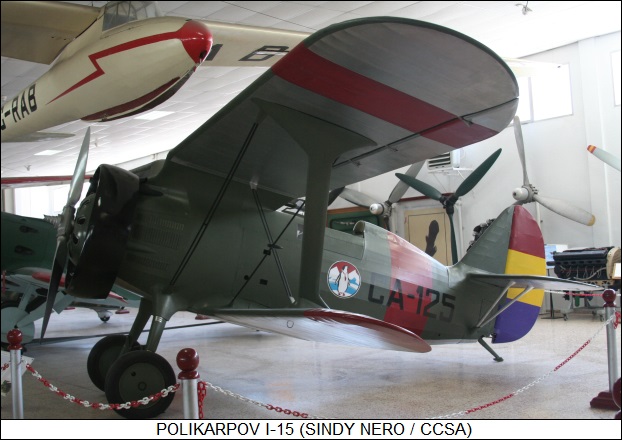
The initial I-15 was not actually much of an advance over the I-5; the intent during development had been to power it with the American Wright Cyclone SGR-1820 nine-cylinder air-cooled radial engine with 520 kW (700 HP), relations with America having undergone a partial thaw after the election of Franklin Roosevelt as president in 1932. The prototype was powered by an imported Cyclone, but the Soviets couldn't get their hands on them in quantity, and so they settled for the M-22 until they could. Cyclones became available in 1936, with 329 I-15s then produced with imported Cyclones or (predominantly) the license-built Soviet version of the Cyclone, the M-25.
___________________________________________________________________
POLIKARPOV I-15:
___________________________________________________________________
wingspan:
9.75 meters (32 feet)
wing area:
23.55 sq_meters (253.3 sq_feet)
length:
6.1 meters (20 feet)
height:
2.2 meters (7 feet 3 inches)
empty weight:
1,012 kilograms (2,230 pounds)
loaded weight:
1,415 kilograms (3,120 pounds)
max speed at sea level:
350 KPH (220 MPH / 190 KT)
service ceiling:
7,250 meters (23,800 feet)
range:
500 kilometers (310 MI / 270 NMI)
___________________________________________________________________
Having substantially more power, the I-15 was fitted with four 7.62-millimeter machine guns and an armored seat. Some sources claim that very late production I-15s were fitted with twin 12.7-millimeter machine guns, instead of the four 7.62-millimeter guns. Again, production quantities are uncertain, the total of I-15 fighters built being given as about 600, with roughly half built under license by CASA of Spain.
* Work on improving the I-15 led to the "I-15bis", where "bis" meant "encore" in Latin / French, with initial flight in 1937 and production beginning in that year. The I-15bis was also known as the "I-15-2" or simply "I-152", the last designation becoming the most familiar. It was generally similar in configuration to the original I-15, but had an M-25V engine with 580 kW (775 HP); a full-length cowling; an upper wing of greater span and area, supported by struts from the fuselage instead of the gull wing arrangement; and more fuel. Armament remained four PV-1 7.62-millimeter machine guns.
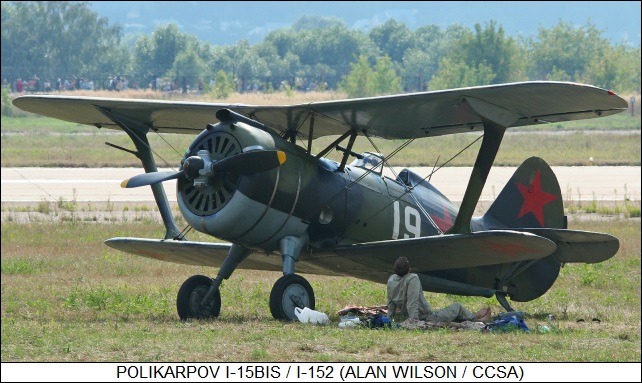
Production quantities of the I-152 are given as about 2,400, with roughly 250 supplied to the Chinese Nationalist government, 50 to the Spanish Republican government, and 40 to the Mongolian People's Republic. A two-seat trainer version, the "DIT-2", was flown, but it is unclear if it entered production. The I-152 was used for various trials, including one fitted with a turbocharger system, another with a pressure cabin, and one even fitted in 1939 with twin DM-2 ramjet boosters under the lower wing, making it one of the few jet-powered biplanes.
* The Soviets were methodical, and on introducing the I-152 work began on a further refined version, which emerged as the "I-15ter" AKA "I-15-3" AKA "I-153", the last designation being the most prevalent. The configuration didn't change greatly, the primary changes being reversion of the upper wing to the "gull" arrangement, leading to the reinstatement of the "Chaika" name, though the wing configuration introduced on the I-152 was retained; and manually-retracted main landing gear.

Armament was changed to four 7.62-millimeter ShKAS machine guns, providing a much higher rate of fire. Initially, the I-153 was powered by the M-25V, but production quickly went on to the Shvetsov M-62 radial engine, a supercharged derivative of the M-25, with 750 kW (1,000 HP).
___________________________________________________________________
POLIKARPOV I-153:
___________________________________________________________________
wingspan:
10 meters (32 feet 10 inches)
wing area:
22.14 sq_meters (238.2 sq_feet)
length:
6.17 meters (20 feet 3 inches)
height:
2.8 meters (9 feet 2 inches)
empty weight:
1,450 kilograms (3,200 pounds)
loaded weight:
1,960 kilograms (4,220 pounds)
max speed at altitude:
445 KPH (280 MPH / 245 KT)
service ceiling:
10,700 meters (35,100 feet)
range:
470 kilometers (290 MI / 255 NMI)
___________________________________________________________________
Initial production deliveries of the I-153 were in 1939. Production totals to end of manufacture in 1941 are given as over 3,400, with about 100 supplied to the Chinese Nationalists. I-153 fighters were also used in various trials, for example being fitted with armament of four 12.7-millimeter machine guns, or twin 20-millimeter cannon; several being fitted with pressure cabins; and one with twin ramjet boosters.
BACK_TO_TOP* While Polikarpov was developing the I-152 from the original I-15, his OKB was also developing a monoplane derivative, to feature the latest aircraft technology. Work on the prototype of a monoplane fighter began in mid-1933, with the machine performing its first flight on 30 December, pilot Valery Chkalov at the controls. Although development had been performed without a VVS requirement, officials were impressed enough to place production orders for the aircraft, given the service designation of "I-16", a month before. It was displayed to the world in a flyover of Moscow on May Day, 1935, as a symbol of Soviet power.
The I-16 had a broad resemblance to the famous American Granville Brothers ("GeeBee") air racers: a low-wing, barrel-shaped monoplane literally built around a radial engine, in the prototype an M-22. The aircraft was of mixed construction -- wooden fuselage with plywood skinning, steel alloy wing spar, duraluminum alloy skinning in the center and leading edges of the wing, fabric covering outboard on the wings. There was a single ShKAS 7.62-millimeter machine gun in each wing, just outboard of the main gear and firing outside the prop arc, while the pilot seat was armored. All flight control surfaces had aluminum alloy frames and fabric skins; the ailerons ran most of the trailing edge of the wing and could be used as flaps.
The cockpit was fully enclosed, the canopy sliding forward, with a telescopic gunsight in the center. There was a small door that hinged downward to ease getting in or out of the cockpit; in early machines, the door was on the left side, in most production there was a door on both sides. The main gear was retractable, the pilot spinning a crank to pivot them from the wings in towards the fuselage. I-16s were sometimes fitted with skis for winter operations, the ski landing gear initially being non-retractable, though retractable ski gear was developed later. The intent for the production version was to use the Wright Cyclone / Shvetsov M-25, with the second prototype using an imported Cyclone. Trials revealed some problems, notably with the Cyclone engine installation -- so early production "Type 4" I-16s used the M-22 engine, being soon replaced on the production line by "Type 5" M-25 machines. The engine drove a two-bladed variable-pitch propeller.
At its introduction, the M-25-powered I-16 was the fastest production fighter in the world, with an excellent climb rate and a crisp roll rate, though it was not as agile as the I-152. The I-16 was not regarded as a good mount for inexperienced pilots, being responsive to the threshold of unstable, but tales that the "Ishak (Donkey)" -- as it was called because of the similarity of that word to the Russian pronunciation of "I-16" -- had vicious spin characteristics are said to be exaggerated. It seems VVS pilots were suspicious of the I-16 spin's characteristics at first, but extensive spin trials showed it was not all that troublesome, and provided rules for how to get out of spins when they did occur. It was, however, hard to get in or out of the cockpit, and cranking in the landing gear was a laborious pain.
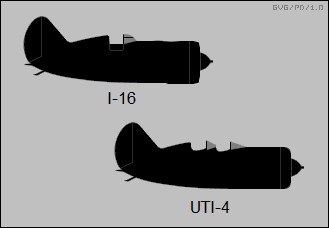
Along with fighter production, an unarmed two-seat trainer powered by the M-22, the "Type 4 UTI-2", was introduced, with about a hundred built. It was quickly replaced in production by the "Type 15 UTI-4" -- much the same, except with an M-25 engine, about 1,800 UTI-4s being built. Production UTI-4 trainers had fixed landing gear.
* The "Type 10" was introduced in late 1936, this variant featuring the more powerful M-25A engine and two more 7.62-millimeter ShKAS machine guns, mounted in the top of the nose and firing through the prop arc; the forward-sliding canopy, which had proven clumsy in practice, was replaced by a fixed windscreen and open cockpit, while the telescopic gunsight was replaced by a cockpit gunsight. Later Type 10 production featured the uprated M-25V engine. Some sources call Type 10s with the M-25A the "Type 6", but that sounds like an error.
The "Type 12" was a Type 5 with the two wing guns replaced by 20-millimeter ShVAK cannon, giving total armament of two cannon and two machine guns. The Type 12 and other I-16 types with the same armament were at least informally known as "I-16P", where "P" stood for "pushyechniy (cannon)". The Type 12 seems to have been built in parallel with the Type 10. The "Type 17", introduced in 1939, was a Type 10 with the same armament upgrade, the Type 17 being built in greater numbers than the Type 12. The cannon imposed a slight climb and speed penalty.
The addition of heavier armament, as well as armor, meant the I-16 suffered from "weight creep", and the uprated M-25 engine variants failed to keep pace. From 1939, the I-16 was seen as obsolescent -- but since next-generation fighters weren't going to be available in the near future, work went ahead to fit the I-16 with more powerful engines.
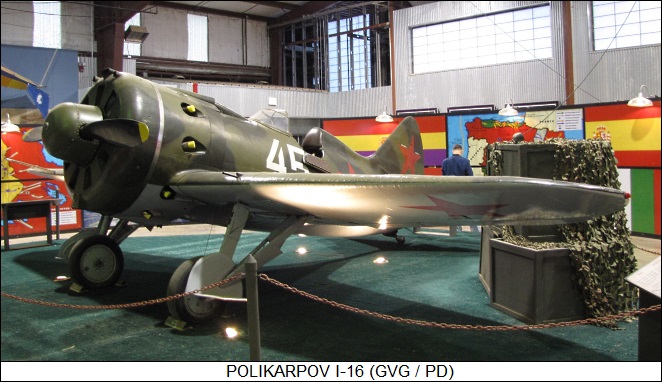
The "Type 18" was introduced in 1939, featuring the four 7.62-millimeter machine guns of the Type 10, plus the Shvetsov M-62 engine -- an improved M-25 with a two-speed supercharger, providing 600 kW (800 HP) -- and a radio. The more powerful engine cut into range, so a "Type 20" was introduced, the only significant refinement being provisions for two jettisonable tub-shaped conformal underwing tanks. An I-16P variant with machine gun / cannon armament was introduced as the "Type 27".
___________________________________________________________________
POLIKARPOV I-16 TYPE 24:
___________________________________________________________________
wingspan:
9 meters (29 feet 6 inches)
wing area:
14.5 sq_meters (156.1 sq_feet)
length:
6.13 meters (20 feet 1 inch)
height:
3.25 meters (10 feet 8 inches)
empty weight:
1,490 kilograms (3,285 pounds)
loaded weight:
1,940 kilograms (4,280 pounds)
max speed at altitude:
525 KPH (325 MPH / 280 KT)
service ceiling:
9,700 meters (31,800 feet)
range with tanks:
700 kilometers (290 MI / 255 NMI)
___________________________________________________________________
The Shvetsov M-62 led to the improved and uprated M-63 radial, with 670 kW (900 HP). The Type 20 was upgraded to this engine and designated "Type 24", going into production in 1940. An I-16P variant was built as the "Type 28". The introduction of the M-63 did not actually improve performance much, mostly due to a mismatch with the propeller but also because of various minor deficiencies of the design, leading to the final I-16 production variant, the "Type 29", with various refinements. One significant change in the Type 29 was to delete the wing guns, instead adding a UBT 12.7-millimeter (0.50-caliber) machine gun in the nose, firing through the propeller arc along with the ShKAS machine guns. The Type 29 could also carry six RS-82 rockets under the wings, along with the auxiliary underwing tanks.
Production of the I-16 ended in 1941. During the I-16's production life, there were also various one-off experimental aircraft based on it, such as a heavily-armored ground attack variant. Total production of the I-16 is given as over 7,000 fighters and almost 1,900 trainers, a quantity of them being supplied to the Nationalist Chinese.

* As a footnote to the I-16's early development history, the Polikarpov OKB also considered an alternate monoplane fighter design, the "I-17", powered by a water-cooled vee-12 engine instead of an air-cooled radial. Two prototypes of the I-17 were built, the first performing its initial flight in September 1934. The I-17 was of mixed construction, with a low-mounted wing, Hispano-Suiza 12Y engine with 565 kW (760 HP), and retractable taildragger landing gear. It had an enclosed cockpit with a forward-sliding canopy, and armament of four 7.62-millimeter ShKAS machine guns. The I-17 demonstrated no performance advantage over the I-16, and so the project was abandoned.
BACK_TO_TOP* While it is tempting to think of the monoplane I-16 as more advanced than the biplane I-15 series, as noted above the two series were more or less parallel developments, and they had roughly parallel combat careers.
After the Spanish Civil War broke out in 1936, with the Leftist Republican government challenged by the Rightist Spanish Army Nationalists, Soviet dictator Josef Stalin decided to aid the Republican government -- though at a price, paid in gold. Hundreds of I-15s and I-16s were dispatched to Spain in the fall of 1936, quickly seeing combat, intimidating Italian and German fliers supporting the Nationalist cause, who at the time were reliant on Fiat CR-32 and Heinkel He 51 biplanes respectively.
The I-15 became known to the Spanish as the "Chato (Snub Nose)" or "Curtiss", because of its (rather broad) resemblance to the comparable American Curtiss Sparrowhawk fighter. The Nationalists called the I-16 the "Rata (Rat)", while the Republicans called it the "Mosca (Fly)". Combat revealed some deficiencies in the Polikarpovs, demanding structural improvements and increased armor, with light armament proving a particular drawback and driving the introduction of the four-gun Type 10 I-16. Ironically, the I-15bis / I-152 proved superior to the I-16 in some respects, which is one of the reasons the Soviets were slow to give up on the biplane fighter configuration. As improved I-15 and I-16 variants went into production, they were sent to Spain, in an attempt to keep up with the introduction of the new and much improved German Bf 109 fighter. Soviet pilots were generally able to hold their own, but they could not prevent the ultimate defeat of the Republicans on the appropriate date of 1 April 1939.
In the meantime, from 1937 the I-15 series and the I-16 were supplied in quantity to the Nationalist Chinese in their fight with Japanese invaders, the aircraft being at least partly flown by Soviet pilots. In the summer of 1939, the Soviets had it out directly with the Japanese in a major clash on the Mongolian border, in the vicinity of the Khalkin Gol River. Although Khalkin Gol was a major victory for the Soviets, it was by no means a cheap one; the Polikarpovs were the mainstay of VVS fighter forces in the clash, and suffered heavily. It was clear by the end of the clash, if it hadn't been before, that the Polikarpov fighters were obsolescent, that something better was needed. One distinction of the I-16 in the clash was first combat use of the RS-82 rocket.
The fight at Khalkin Gol had the effect of normalizing relationships between the USSR and Japan, with the result that the Soviet Union distanced itself from the Chinese Nationalist regime. However, the Polikarpov fighters, including the I-153, remained in first-line Nationalist service into 1943.
* By the time Nazi Germany invaded the USSR on 22 June 1941, the I-15 series and the I-16 were obsolescent. Many were destroyed on the ground in the first-day blitz. The I-15, as noted, was used to an extent in the close-support role; it had an advantage in being able to operate off of short unimproved airfields. The I-16 was used in close-support as well, but also in air combat. While the I-16 had been comparable to the early-model Bf 109s encountered in Spain, it was clearly lagging in capability behind the second-generation Bf 109F series and the later Focke-Wulf Fw 190. Inflexible VVS tactics also resulting in high losses of I-16s.
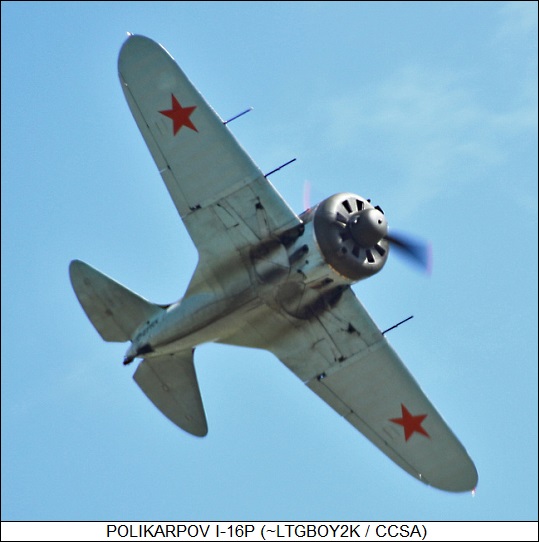
There was such an element of desperation among the defenders that there were many cases of I-16 pilots actually ramming enemy bombers. The pilots who survived acquired better tactics, and in the hands of a pilot who understood the I-16's weaknesses and strengths, it could be a dangerous adversary for German pilots. Although well slower than a Bf 109, the I-16 was sturdy and agile, making it hard to hit, and lethal to any German who was foolish enough to get into a turning contest with it. Some VVS pilots racked up considerable numbers of kills with the I-16.
The I-16 also proved its worth in the ground-attack role, using rockets and small bombs along with its gun armament. In one particularly daring application, following up prewar experiments, into the fall of 1941, antiquated Tupolev Tu-3 bombers were used as "flying aircraft carriers", with an I-16 under each wing. The Tu-3s hauled the fighters, configured as fighter-bombers, to then release them, the I-16s then performing dive-bombing attacks, and hopefully return to base on their own power. However, from the first day of the war in the East, the I-16 was living beyond its time. Most I-16s had been phased out of service by the summer of 1943.
The Germans and German Axis allies fighting in the East captured a number of Polikarpov fighters. The Finns apparently used captured I-15 series and I-16 machines in combat, though the story is obscure. Amusingly, the Finns called the I-16 the "Siipiorava (Flying Squirrel). A number of Polikarpov fighters have been restored to an airworthy condition, to fly in airshows in the 21st century.
BACK_TO_TOP* As the I-16 grew obsolescent, Polikarpov's career in aircraft design went gradually on the fade -- in part because some of his best designers, such as Artyom Mikoyan, moved on to their own OKBs, to become competitors for resources. The Polikarpov OKB did work on a follow-on to the I-16, the "I-180", the development team being led by Dmitriy Tomashevich, one of Polikarpov's deputies.
The I-180 had much the same configuration as the I-16, but was sleeker and even more suggestive of a GeeBee racer. Length was 6.88 meters (22 feet 7 inches), wingspan was 10.09 meters (33 feet 10 inch), and empty weight was 2,046 kilograms (5,414 pounds). It was powered by a Tumanskiy M-88 14-cylinder two-row air-cooled radial engine with 820 kW (1,100 HP). Armament was four 7.62-millimeter ShKAS machine guns, with two in the nose and two in the wings. The first I-180 prototype performed its initial flight on 15 December 1938, being lost on that same flight due to engine failure; the pilot, Valeriy Chkalov, was killed. Tomashevich and several other OKB officials were arrested for "treason" as a consequence -- though Polikarpov escaped that fate, not having approved the flight.
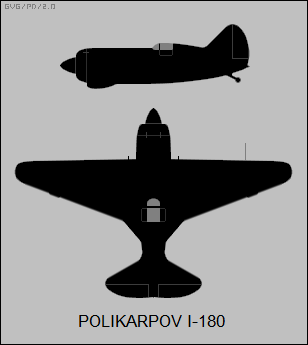
A second prototype was first flown on 19 April 1939; it crashed on its 53rd flight on 5 September, pilot Thomas Suzi bailing out but being killed when his parachute didn't deploy. A third prototype, incorporating fixes, performed its first flight on 10 February 1940. It featured an M-88R engine and armament of two 7.62-millimeter ShKAS and two 12.7-millimeter UBT machine guns. It, too, was lost in an accident, on 5 July 1940, during the course of state trials; the pilot, A. Proshakov, managed to bail out safely. Despite all the difficulties with the flight test program, an order was placed for ten pre-production aircraft. It is unclear that the entire batch was built, interest then moving on to other fighter designs.
Astoundingly, even at this late date the VVS still had interest in biplane fighters, leading to the "I-190" -- effectively an I-153 with an M-88 engine. First flight of the prototype was on 30 December 1939, with various tinkerings with the aircraft into 1941. It was lost in a crash in July 1941; the project was then abandoned, along with plans for a further improved "I-195" biplane fighter.
* The I-180 had been canceled largely because Polikarpov was working on a more impressive follow-on design, the "I-185", which in hindsight seemed comparable to the German Focke-Wulf Fw 190, though with a configuration clearly descended from the I-16. The I-185 was a low-wing monoplane of mixed construction, fully enclosed cockpit, and retractable tailwheel landing gear, powered by a radial engine -- exactly which one proved a moving target -- and armed with twin 7.62-millimeter ShKAS plus twin 12.7-millimeter UBT machine guns, all mounted in the nose.
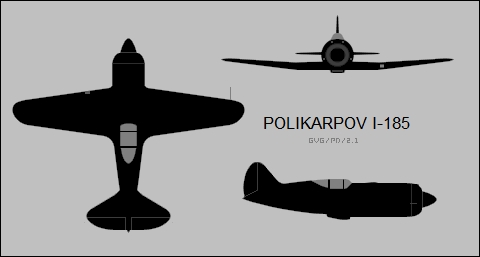
An initial prototype, to be powered by a Shvetsov M-90 engine with 1,305 kW (1,750 HP), was built in 1940, but was never flown because of non-availability of production engines. A second prototype was built, performing factory trials from May 1941, being powered by a 14-cylinder two-row Shvetsov M-82 engine, initially with 990 kW (1,330 HP) -- later with 1,045 kW (1,400 HP) -- driving a three-bladed variable-pitch propeller with a large prop spinner. Armament was changed to three 20-millimeter ShVAK cannon, firing through the prop arc.
___________________________________________________________________
POLIKARPOV I-185:
___________________________________________________________________
wingspan:
9.8 meters (32 feet 2 inches)
wing area:
15.53 sq_meters (167.1 sq_feet)
length:
7.77 meters (25 feet 6 inch)
height:
2.5 meters (8 feet 2 inches)
empty weight:
2,655 kilograms (5,840 pounds)
loaded weight:
3,500 kilograms (7,700 pounds)
max speed at altitude:
630 KPH (390 MPH / 340 KT)
service ceiling:
11,000 meters (36,100 feet)
range:
835 kilometers (520 MI / 450 NMI)
___________________________________________________________________
A third prototype -- at first powered by a Shvetsov M-81 18-cylinder two-row radial, then by the more powerful Shvetsov M-71, with 1,420 kW (1,900 HP) -- joined the first two, with the first prototype being re-engined with the M-71 and the three undergoing state trials. Although the first prototype crashed, the pilot being killed, the I-185 proved fast, maneuverable, well-armed, and relatively easy to fly, superior to all Soviet and foreign fighters in comparative evaluations. It was clearly an outstanding aircraft; sadly, the I-185 never went beyond trials, due to limited manufacturing capability for both airframe and engine, as well as ongoing problems with the M-71 engine.
BACK_TO_TOP* In the meantime, in late 1938 Polikarpov came up with a proposal for a twin-engine two-seat "heavy escort fighter", "Tyazhely Istrebitel Soprvozhdeniya (TIS)". Development work didn't start on it for almost two years, with Mikhail Yangel -- later a prominent Soviet space engineer -- leading the design team. The first TIS prototype, "Samolet (Aircraft) A", performed its initial flight in September 1941, the pilot being N. Gavilov.
The TIS had a resemblance to the Petlyakov Pe-2 tactical bomber, being a low-wing monoplane of all-metal construction, with a twin tail. It was powered by two Mikulin AM-37 water-cooled vee-12 engines with 1,045 kW (1,400 HP) each, driving three-bladed variable-pitch propellers. Length of the TIS was 11.7 meters (38 feet 5 inches), wingspan was 15.5 meters (50 feet 10 inches), and empty weight was 5,800 kilograms (12,785 pounds). The wing featured four-section flaps and leading-edge slats. The TIS was fitted with tailwheel landing gear, all gear being retractable, the main gear being on "H"-type struts and retracting backward into the engine nacelles.
Armament originally consisted of:
There was a rack under each wing that could carry up to a 500-kilogram (1,100-pound) bomb. The pilot would perform bombing attacks either by dive bombing, or by dropping the bombs on cue from a "formation leader" aircraft carrying a bombardier. Instruments included a radio, radio compass, gyro-compass, and gyro-horizon.
Engine problems plagued the trials; then the German invasion and work on other aircraft designs, particularly the I-185, put the TIS program on hold. After the I-185 program was canceled, a second and refined TIS prototype, the "Samolet MA", was built, performing its first flight on 13 June 1944, again with Gavilov at the controls. It was powered by twin Mikulin AM-38F vee-12 engines providing 1,240 kW (1,665 HP) each, and had a number of aerodynamic improvements. Armament was changed to twin 12.7-millimeter UBT machine guns in the nose; an UBT machine gun in the rear of the cockpit, but no ventral gun; and twin 37-millimeter Shpitalniy cannon, one in each wing root, with the 45-millimeter Shpitalniy cannon anticipated for production machines. The UBT machine gun barrels protruded from the nose, providing a distinctive recognition feature relative to the first prototype. Trials went well enough, but the Samolet MA was damaged in a belly landing in September; it would never fly again.
* In a roughly parallel effort, from 1941 Polikarpov also worked on a single-seat, single-engine fighter with heavy cannon armament, the "Istrebitel Tyazhely Pushyechniy (ITP)", which was to be armed with a 37-millimeter cannon firing through the prop spinner, the cannon barrel extending between the banks of a water-cooled inline vee engine, plus twin 20-millimeter ShVAK cannon firing through the prop arc.

Due to problems with the engine selection, the initial ITP prototype, the "M-1", didn't perform its first flight until 23 February 1942. It was a low-wing monoplane of mixed construction, with tailwheel landing gear, all gear assemblies being retractable, the main gear hinging in the wings towards the fuselage. Length was 8.9 meters (29 feet 2 inches), wingspan was ten meters (32 feet 10 inches), and empty weight was 2,960 kilograms (6,525 pounds). It was powered by a Klimov M-107P engine, providing 970 kW (1,300 HP) and driving a variable-pitch three-bladed propeller. The engine proved problematic, engine failures being common.
Following various tweaks and static tests on the M-1 prototype, a second prototype, the "M-2", first flew on 23 November 1943, being powered by an AM-39 engine with 1,195 kW (1,600 HP), the AM-37 having proven unreliable beyond saving. The 37-millimeter cannon was swapped out for a 20-millimeter ShVAK cannon, giving an armament of three 20-millimeter cannon; the M-2 also had underwing racks for eight unguided rockets, the ITP being envisioned as having a secondary attack role.
Factory trials continued into the summer of 1944, but though the ITP seemed a good aircraft, it wasn't better than fighters already in VVS service, and there was little interest in producing it. Polikarpov died of cancer on 30 July 1944, with his OKB then abandoned, the TIS and ITP programs being canceled. It was a humble end to a noteworthy career; Polikarpov would only be remembered fondly for his Po-2 trainer / utility aircraft, which was built in huge quantities. However, in their time the I-15 series and I-16 were advanced aircraft, they were just forced to serve past their obsolescence; Polikarpov's later designs might well have made a name for themselves, but events conspired to ensure they never went into production.
BACK_TO_TOP* The history of the Polikarpov I-15 series and the I-16 shows that the VVS was ambivalent about the relative virtues of biplane and monoplane fighters. As a consequence, an aircraft designer named Vasily Nikitin, working with a pilot named Vladimir Shevchenko, came up with an idea that, in hindsight, seems equally brilliant and crazy: a fighter that could change in flight from a biplane to a monoplane. The primary motivation appears to have been short-field capability, not combat performance.
The design was called the "Istrebitel Skladnoy (IS / Folding Fighter)", with the initial IS-1 prototype flying in 1940. It had a distinct resemblance to an I-153, at least on the ground, being a biplane with a top gull wing and a short-span lower wing, plus a radial engine, open cockpit, and tailwheel landing gear. It was powered by a Shvetsov M-63 radial engine, driving a three-bladed variable-pitch propeller with a large prop spinner. Armament was four 7.62-millimeter ShKAS machine guns, all fitted in the top wing. Length was 6.79 meters (22 feet 3 inches), span was 8.6 meters (28 feet 2 inches), while empty weight was a mere 1,400 kilograms (3,085 pounds).
The tailwheel was fixed; the main gear was retractable, but in an unusual fashion -- the bottom wing hinging up under control of an actuator strut, the inboard part of the wing folding into the fuselage, the outboard part folding into the bottom of the top wing; the main gear tucking into the fuselage on top of the inboard wing section. It must have been interesting to watch the wing / landing gear retraction process.

Trials proving the concept at least workable, a second prototype, the "IS-2", flew in 1941. This machine featured a Tumanskiy M-88 radial; the bigger new engine was in a longer and more streamlined cowling, with a large prop spinner. Length was extended to 7.36 meters (24 feet 2 inches); the tailfin height was reduced, and the tailwheel was made retractable. Span remained the same, as did armament, though the more powerful engine made guns of bigger caliber practical.
Even with its improvements, the IS-2 could not quite match the performance of the new MiG and Yak fighters then being introduced. However, Nikitin still came up with designs for further improved IS-3 and IS-4 prototypes -- but the IS program was canceled following the German invasion in the summer. The IS has to be regarded as one of the final steps in the evolution of the biplane fighter design, an ingenious idea for a class of aircraft that was a dead end.
* The primary source for this document was:
The online Wikipedia was also consulted. Unfortunately, the documentation trail on relatively obscure old Soviet aircraft tends toward the sketchy and unreliable.
* Revision history:
v1.0.0 / 01 dec 13 v1.0.1 / 01 nov 15 / Review & polish. v1.0.2 / 01 oct 17 / Review & polish. v1.0.3 / 01 sep 19 / Review & polish. v1.0.4 / 01 jul 21 / Review & polish. v1.0.5 / 01 jun 23 / Review & polish. v1.0.6 / 01 jun 25 / Review & polish. (*)BACK_TO_TOP
